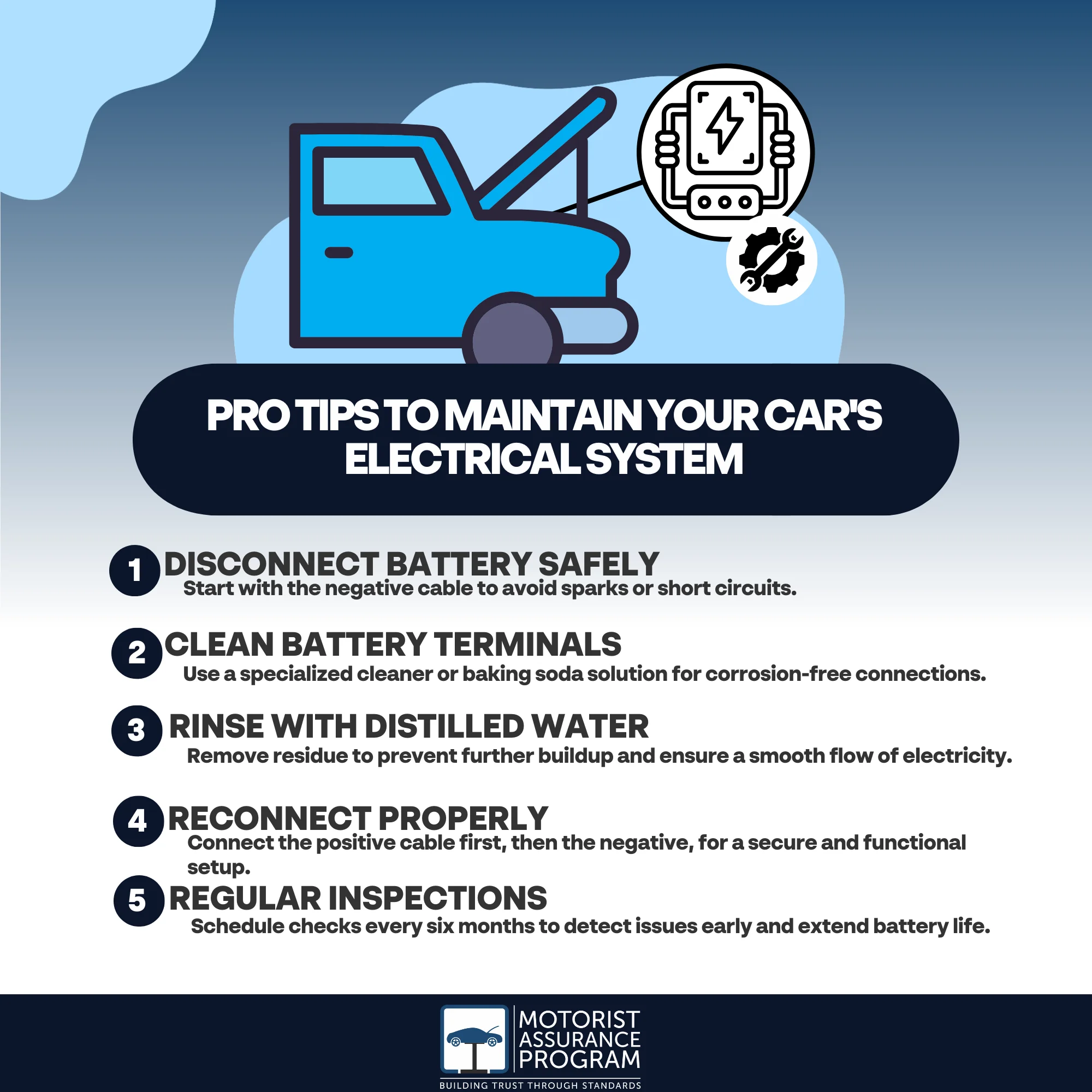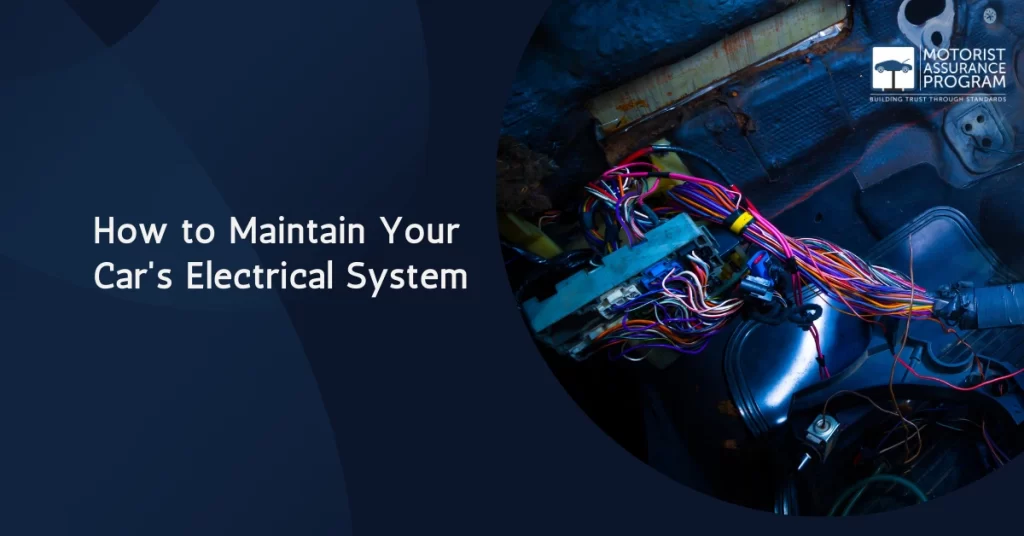To maintain your car’s electrical system, start by disconnecting the battery cables—negative first to reduce spark risks. Clean the battery posts and cable ends with a specialized cleaner or a baking soda solution, using a wire brush to remove corrosion. After cleaning, rinse them with distilled water to eliminate any residue, vital for preventing further corrosion. Once dry, reconnect the positive cable first, followed by the negative. Regular checks on your battery and electrical connections can strengthen your vehicle’s reliability and prevent costly repairs. For more effective maintenance tips, explore these additional practices to guarantee peak performance.

Key Takeaways
- Regularly inspect and clean battery terminals and cable ends to prevent corrosion and ensure optimal electrical contact.
- Disconnect the negative battery terminal first when performing maintenance to minimize the risk of sparks or short circuits.
- Use a specialized battery cleaner or baking soda solution to remove buildup, and rinse with distilled water to eliminate cleaning residue.
- Reconnect battery cables by attaching the positive terminal first, followed by the negative, ensuring all connections are tight and free from corrosion.
- Schedule periodic checks on the electrical system to increase battery longevity, preventing unexpected issues and costly repairs.
Remove the battery cables from the battery posts
Have you ever wondered how to safely disconnect your car’s battery? It’s vital for maintaining the car electrical system and preventing any accidental short circuits. Start by checking that your car is turned off and parked on a level surface. Put on safety goggles and gloves to protect yourself from any corrosive materials.
Locate the battery under the hood. Identify the negative (-) and positive (+) terminals. Always disconnect the negative terminal first to minimize the risk of sparks. Use a wrench to loosen the bolt on the negative cable and gently lift it off the battery post. Make certain it doesn’t touch any metal surfaces.
Next, repeat the process for the positive terminal. Loosen the bolt, and carefully remove the cable from the battery post. Ensure you handle the cables with care to avoid damaging the connectors. This step is vital for any car electrical system repair you plan to perform, as it helps prevent any electrical surges that could damage the electrical system of a car. Properly removing the battery cables sets the stage for safe maintenance and guarantees the longevity of your vehicle’s electrical components.
Clean the posts and the cable ends using the fluid and a wire brush
After disconnecting the battery cables, it’s important to clean the battery posts and cable ends to guarantee a solid connection when reassembling. Start by applying a specialized battery cleaner or a baking soda and water solution to neutralize any acid buildup. This step is necessary to prevent corrosion, which can lead to poor performance in your car’s electrical system.
Using a wire brush, scrub the battery posts and cable ends thoroughly. Make sure to remove all corrosion and debris, as this can significantly impact the effectiveness of your car electrical system check. A clean connection assures that electrical current flows freely, preventing potential issues that could result in higher car electrical repair costs later on.
Once you’ve scrubbed the posts and cable ends, inspect them for any signs of damage. If you notice any cracks or excessive wear, consider replacing the cables to maintain the integrity of the electrical system in your car. Regular maintenance of these components is key to preventing future problems and guaranteeing your vehicle runs smoothly. Taking these steps will help prolong the life of your battery and the overall electrical system.
Rinse the battery cables and posts with water
Rinsing the battery cables and posts with water is a key step in the cleaning process. After using a wire brush and cleaning solution to remove corrosion, it’s important to rinse away any residue. This helps prevent future corrosion and guarantees a solid connection within your car’s electrical system.
Using distilled water is recommended, as it won’t introduce impurities that can affect the car electrical system diagram or components. Once rinsed, let the cables and posts dry completely before reinstallation.
If you neglect this step, you might encounter electrical problems, such as poor battery performance or failure to start.
Even if you’re wondering, “Do electric cars need maintenance?” the answer is yes—regular cleaning of battery terminals is necessary for all vehicles. If you experience issues like dimming lights or starting failures, it may signal what happens when your car has electrical problems, often linked to dirty or corroded connections. Rinsing the battery cables and posts is a simple yet effective way to maintain your car’s electrical integrity and longevity, keeping your vehicle running smoothly.
Re-connect the battery cables
To guarantee a safe and effective reinstallation, start by reconnecting the battery cables with the positive side first. This process is essential for your car’s electrical system to function properly. First, take the positive cable, which is usually marked with a red color or a plus sign (+). Secure it firmly to the positive terminal of the battery, ensuring a clean contact.
Next, move to the negative cable, which is typically black and marked with a minus sign (-). Connect it to the negative terminal. Remember, always connect the positive side before the negative to prevent any short circuits, which can damage the electrical car system.
If you’re wondering, “Do electric cars need servicing?” the answer is yes! Regular checks, including battery maintenance, are essential for longevity. Following an electric car maintenance schedule will help you avoid unexpected issues.
After reconnecting the cables, double-check they’re tight and free from corrosion. Once you’ve completed this step, you can proceed to start your vehicle, ensuring everything operates smoothly. Regular maintenance like this keeps your car’s electrical system in prime condition.
Frequently Asked Questions
How Often Should I Check My Car’s Electrical System?
You should check your car’s electrical system at least once every six months. Regular inspections help identify issues early, ensuring reliable performance and preventing potential breakdowns. Don’t overlook battery health, wiring, and connections during checks.
What Are the Signs of a Failing Alternator?
If your car’s lights flicker like an old disco ball, it might signal a failing alternator. Other signs include dimming headlights, strange noises, and battery warning lights. Don’t ignore these; they can lead to bigger issues.
Can I Use Any Battery Cleaner?
You can’t use just any battery cleaner. Look for a product specifically designed for automotive batteries, as it effectively removes corrosion without damaging connections. Always follow the manufacturer’s instructions for safe and proper usage.
How Do I Know if My Battery Is Dead?
You can tell if your battery’s dead by checking for dim headlights, a slow engine crank, or using a multimeter to measure voltage. A reading below 12.4 volts usually indicates it’s time for a replacement.
What Tools Are Needed for Electrical System Maintenance?
You’ll need a multimeter to check voltage and continuity, wire strippers for repairs, a socket set for battery terminals, and a few wrenches. Having a basic toolkit simplifies diagnosing and fixing electrical issues effectively.
Conclusion
By regularly maintaining your car’s electrical system, you guarantee its heart keeps beating strong. A clean battery connection can mean the difference between a smooth ride and a frustrating breakdown. With a little effort, you can extend your vehicle’s lifespan and improve its performance. So, roll up your sleeves and give your battery the attention it deserves—your car will thank you with every turn of the key. Keep driving forward, knowing your electrical system is in the best shape.


